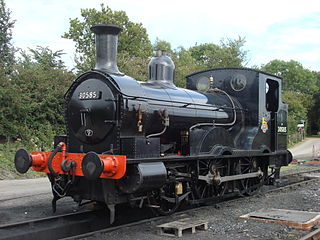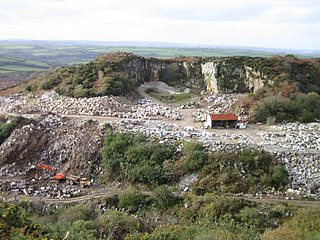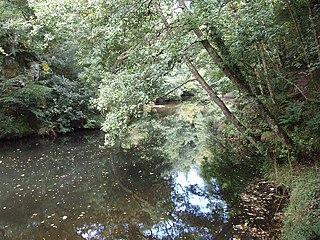
The Bodmin and Wenford Railway is a 6 miles 12 chains (9.9 km) heritage railway at Bodmin in Cornwall, England. Its headquarters are at Bodmin General railway station and it connects with the national rail network at Bodmin Parkway.

The London and South Western Railway (LSWR) 0298 Class or Beattie Well Tank is a class of British steam locomotive. They are 2-4-0WTs, originally built between 1863 and 1875 for use on passenger services in the suburbs of London, but later used on rural services in South West England. Out of a total production of 85, two locomotives have been preserved, both in operational condition.

The Bodmin and Wadebridge Railway was a railway line opened in 1834 in Cornwall, England, United Kingdom. It linked the quays at Wadebridge with the town of Bodmin and also to quarries at Wenfordbridge. Its intended traffic was minerals to the port at Wadebridge and sea sand, used to improve agricultural land, inwards. Passengers were also carried on part of the line.

The Great Western Railway (GWR) 4575 Class is a class of 2-6-2T British steam locomotives.

Bodmin Parkway railway station is on the Cornish Main Line that serves the nearby town of Bodmin and other parts of mid-Cornwall, England. It is situated 3 miles (4.8 km) south-east of the town of Bodmin in the civil parish of St Winnow, 274 miles 3 chains from London Paddington measured via Box and Plymouth Millbay. Network Rail’s National Rail Timetable dated May 2023 records the distance from London Paddington to Bodmin Parkway as 252.50 miles.

The Camel Trail is a permissive cycleway in Cornwall, England, United Kingdom, that provides a recreational route for walkers, runners, cyclists and horse riders. The trail is flat ; running from Padstow to Wenford Bridge via Wadebridge and Bodmin, it is 17.3 miles (27.8 km) long and used by an estimated 400,000 users each year generating an income of approximately £3 million a year.

Alfred and Judy are two 0-4-0 saddle tank steam locomotives. They were built by W. G. Bagnall for use at Par Docks in Cornwall, United Kingdom. The unusually low design was required to cope with extremely tight curves and a very low bridge under the Cornish Main Line. The locomotives are both preserved in operational condition on the nearby Bodmin and Wenford Railway and inspired the Reverend Wilbert Awdry to include them in The Railway Series of children's books as Bill and Ben.

De Lank Quarries is an active quarry and a 54-acre geological Site of Special Scientific Interest in St Breward parish, north Cornwall, England, UK. The quarry, which received its SSSI notification in 1994, takes its name from the nearby De Lank river. The quarry produces typical biotite granites and are of such quality that a slab now forms the base section of the reception desk at the Geological Society of London. Other notable structures built of De Lank granite are the fourth Eddystone Lighthouse, 1882; the Royal Opera House in Covent Garden, London and the New Parliamentary Building in Whitehall, London

The London and South Western Railway T9 class is a class of 66 4-4-0 steam locomotive designed for express passenger work by Dugald Drummond and introduced to services on the LSWR in 1899. One example has been preserved after British Railways ownership. They were given the nickname of "Greyhounds" due to their speed, up to 85 miles per hour (137 km/h), and reliability.

Joseph Hamilton Beattie (1808-1871) was a locomotive engineer with the London and South Western Railway. Joseph Beattie was born in Ireland on 12 May 1808. He was educated in Belfast and initially apprenticed to his father, a Derry architect. He moved to England in 1835 to serve as an assistant to Joseph Locke on the Grand Junction Railway and from 1837 on the London and Southampton Railway. After the line opened he became the carriage and wagon superintendent at Nine Elms and succeeded John Viret Gooch as locomotive engineer on 1 July 1850.

Wadebridge railway station was a railway station that served the town of Wadebridge in Cornwall, England. It was on the Bodmin and Wadebridge Railway.
There are eight disused railway stations between Wadebridge and Bodmin North on the former Bodmin and Wadebridge Railway in Cornwall, in the United Kingdom, with ten other closed sidings on the branches to Ruthern Bridge and Wenfordbridge. The section from Boscarne Junction to Bodmin General is currently part of the Bodmin and Wenford Steam Railway; the line from Wadebridge to Wenfordbridge is now part of the Camel Trail, and the line to Ruthern Bridge can be followed for much of its length as it runs parallel to a public road.

Bodmin General railway station, located in Bodmin, Cornwall, United Kingdom, was the terminus of the Great Western Railway's Bodmin branch line, and is now the principal railway station of the heritage Bodmin & Wenford Railway.

Colesloggett Halt is a small railway station on the Bodmin and Wenford Railway, a heritage railway in Cornwall, England, United Kingdom.

Padstow railway station was the western terminus of the North Cornwall Railway. It was opened in 1899 by the London and South Western Railway (LSWR) to serve the port of Padstow. It closed in 1967 having been proposed for closure in the Beeching Report.
Six of the only 14 Bagnall fireless locomotives built by W. G. Bagnall of Stafford, England, have been preserved. Brief histories of them are given in this article and they are listed by works number. All are standard gauge 0-4-0s except where otherwise stated.

Boscarne Junction railway station is a railway station on the Bodmin and Wenford Railway in Cornwall, England, United Kingdom, and is its current terminus of the railway. It is adjacent to the Camel Trail, a long-distance footpath and cycle trail.

Dunmere s a hamlet in Cornwall, England, United Kingdom. It is situated one mile northwest of Bodmin in the valley of the River Camel on the A389 road.

The rolling stock of the Bodmin and Wenford Railway are the locomotives, carriages and wagons used on the Bodmin and Wenford Railway, a heritage railway in Cornwall, England.

















